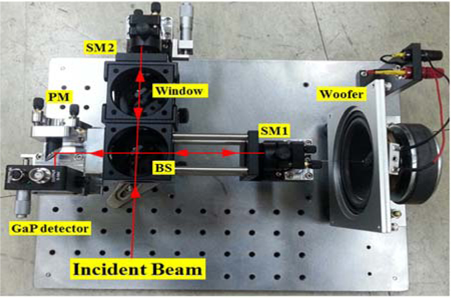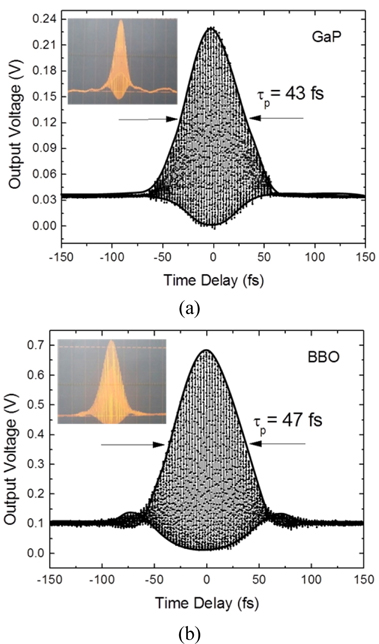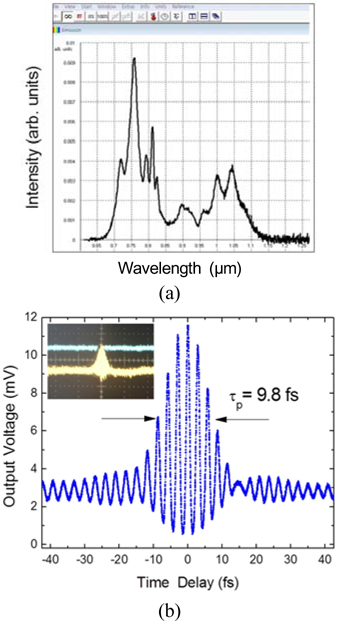



Most pulse diagnostic techniques for an ultrashort optical pulse rely on the detection of light generated by the second or the third order nonlinear processes. An optical autocorrelation based on a Michelson interferometer has most commonly been used to infer the temporal width of a pulse from a mode-locked laser [1]. Conventionally, the Michelson interferometer splits an optical pulse into two replicas with a relative time delay and recombines them for the second harmonic generation (SHG) in a nonlinear crystal. The SHG signal has usually been measured by a photodiode or a photomultiplier tube (PMT). Over the past decades, semiconductors exhibiting two or three photon absorption (TPA or 3PA) features have attracted much interest as a suitable single piece replacement for the SHG nonlinear optical crystals and PMT. Unlike fragile nonlinear crystals with a thickness of a few tens or hundreds of µm, semiconductors are robust and inexpensive, and best of all they are insensitive to the phase matching for the signal generation from TPA or 3PA. Phase mismatch, in particular, can lead to a spectral-filtering effect to make a measured autocorrelation function significantly distorted. Several groups have demonstrated that TPA or 3PA based processes can be effective for pulse diagnostics in the femtosecond and picosecond time range with photodiodes using Si [2, 3], GaAsP [2, 4-7], InGaAs [8], SiC [9, 10], ZnSSe [11], GaN [12], light-emitting diodes using AlGaAs [13], laser diodes using GaAsP [3], GaAs/AlGaAs [14], GaN [15] and photocathodes using CsI and CuI PMTs [16] in autocorrelator schemes. Other semiconductor waveguides and microcavity structure devices were also developed [17-19]. Semiconductor sensors offer high sensitivity and ease of use in compact integrated solid-state devices which are insensitive to frequency chirp and polarization. Collecting photo-carriers excited by a two or three photon process in a device integrates the nonlinear process and measurement operation to make the pulse diagnostic simple. As a result, the small interaction length inherent to these devices allows straightforward operation for spectrally broad pulses without concerns for phase matching.
Over the last decades there has been rapid progress in the development of ultrashort pulse lasers and pulse diagnostics. Although techniques such as frequency-resolved optical gating (FROG) [20] and spectral phase interferometry for direct electric-field reconstruction (SPIDER) [21] enable complete characterization of the amplitude and phase of ultrashort pulses, such techniques require complex setups and mathematical retrieval procedures. Multiphoton intrapulse interference phase scan (MIIPS) is another method that is capable of simultaneously measuring and compensating the phase of a femtosecond pulse using an adaptive pulse shaper [22], which has been applied to characterize the pulse and to manipulate the pulse to a specific shape. These techniques also require bulky and expensive apparatus, which still uses a nonlinear crystal to get a spectrogram or a sonogram to retrieve the amplitude and phase of optical pulses. Although an interferometric autocorrelation measurement cannot provide complete information on the electric field and phase, it is still widely used to allow a real-time estimate of the pulse duration. The chirp magnitude of a pulse can also be deduced from the autocorrelation function [1].
Photocurrents induced by TPA based on the photovoltaic effect in various types of semiconductors are as low as sub nano-ampere, which should be amplified to measureable quantity by an external current amplifier. Meanwhile, there have been few reports on simple semiconductor detectors based on photoconductive TPA phenomena, where current amplification was integrated and converted the current to a moderate output voltage. This kind of semiconductor device would remove the use of an external current amplifier and make the autocorrelator compact and robust. However, the current amplification tends to increase the noise, and may limit the detection bandwidth to give poor resolution, which distorts fringes to be unresolved in an interferometric autocorrelation signal. To fully resolve an interferometric autocorrelation for sub-10 fs pulses, the detector should have a bandwidth as high as ~ 100 KHz. Recently Chong et al. reported a sensitive autocorrelation measurement based on TPA using a photoconductive GaP detector with a spectral response extending from 680 to 950 nm [23]. Although they demonstrated the feasibility of measuring TPA-based response covering the entire spectral range of a Ti:Sapphire laser by a single detector, they did not pay attention to the dynamic range and the bandwidth limit of a switchable gain amplifier embedded in the detector, which would offer a compromise between the strength and the speed of the signal voltage. A proper choice should make all fringes clearly resolved in an interferometric autocorrelation trace and put a real-time readout of autocorrelation function into practice.
In this study, we report on a compact real-time autocorrelator using a switchable gain photoconductive GaP detector, where an invert-biased pin GaP diode was illuminated to invoke the photocurrent excited by two photon absorption. An internal operational amplifier circuit converts the current into an output voltage, and controls the output gain in 10 dB steps by switching to one from a list of feedback resistors. With a suitable gain adjustment, it delivers output voltage as high as a few tens of millivolts for the laser input power as low as 15 mW while maintaining the real-time readout of the interferometric autocorrelation trace with high resolution. The GaP photodiode shows a peak response at 430 nm and nearly linear spectral response from 150 to 550 nm. At sufficiently high input power, TPA should dominate over the linear absorption for pulses with spectral components ranging from 600 to 1100 nm. The device is highly favorable for measuring a few cycle pulses from a Ti:Sapphire oscillator with a spectral bandwidth > 380 nm at 800 nm center wavelength. We have measured the quadratic photoconductivity dependence of GaP photodiode on the incident power and estimated the quantum efficiency for the TPA process. We have compared output characteristics between the SHG process by using a thin BBO crystal and the TPA process using a GaP photodiode. We have also demonstrated that the photodiode is highly suitable for the real-time readout of a pulse as short as sub-10 fs in duration with its spectra covering from 650 to 1150 nm.
As a single detector, we used a commercially available GaP photoconductive amplifier (PDA25K, Thorlabs Inc.) to develop a compact and robust autocorrelator for displaying a real-time autocorrelation trace without any external amplifier. This photodetector contained a low-noise, low-offset and switchable transimpedance internal amplifier to adjust the gain over 70 dB. The light sources were two home-built Ti:Sapphire oscillators; one was equipped with a fused silica prism pair, which provided pulse duration of a few tens of femtoseconds at 83 MHz repetition rate, and the other was equipped with a double-chirped mirror set (DCM 7, Venteon Inc.), which delivered sub-10 fs pulses at 77 MHz repetition rate. The spectrum of sub-10 fs pulses was measured by an NIR spectrometer (IrSys® E).
The autocorrelation setup (11×15 inch2 in size) is illustrated in Fig. 1. It has a Michelson interferometer configuration as in a conventional autocorrelator based on an SHG crystal and a PMT, except that the SHG crystal and the PMT were replaced by the photodetector. The incident pulse was split into two replicas by a beam splitter (50:50) of low group delay dispersion (GDD) and directed to reflecting silver mirrors SM1 and SM2. A thin window was inserted into a pathway of the transmission arm to compensate for the GDD difference between the two arms. The reflected pulses from SM1 and SM2 were overlapped and tightly focused onto the detector surface by an off-axis parabolic silver mirror having a focal length of 25 mm. A woofer was installed at the end of the reflection arm for a delay scan and was driven for a real-time display by a sine wave at 1 Hz refresh rate from the output terminal of a digital function generator (Stanford Research System, DS335). To survey the power dependent photoconductivity of the detector, incident power was reduced and adjusted by a neutral density filter in front of the autocorrelator. The output voltage from the detector was measured by a digital oscilloscope (Lecroy 9310A, TDS3044B) having a bandwidth of 400 MHz. The gain switch of the GaP detector was mostly held to 30 dB setting, which attained transimpedance gain of 2.38 × 104 V/A for low output impedance load (50 Ω) [24].
Figure 2 shows the log-log plot of peak-peak voltage of autocorrelation traces measured with GaP detector as a function of incident power for 50 fs pulses from a Ti:Sapphire oscillator centered at 800 nm. The output voltage shows a quadratic dependence with a slope of 2.04 indicating that the photo-generated current is due to the TPA process. The GaP detector has an inverse-biased pin photodiode. If there is no proper current induced by two photon absorption, there is also no forward current or output voltage. The threshold incident power at 40 dB setting for displaying a complete autocorrelation trace was as low as 14 mW, where the peak voltage was as high as 50 mV with good signal to noise ratio. Taking into account the double pass through the BS in the autocorrelator, threshold input power incident onto a GaP photodiode is below 3.5 mW, indicating a response to pulse energy as low as 42 pJ. At a maximum power of 280 mW in this study, the peak voltage exceeding 600 mV was displayed through a 50 Ω impedance terminal of the oscilloscope. With the maximum input power, neither a saturation of the output nor damage of the photodiode was observed. From the measured quadratic output data, we can calculate the sensitivity (or quantum efficiency) for the two photon process,
where
To get high performance and wide utility, the autocorrelator should display low noise and undisturbed signals. A current amplification may produce unwanted noises and lower the bandwidth of a detector, which is inversely proportional to the gain. The bandwidth limit of a detector results in a disturbed interferometric autocorrelation trace, at which the fringe pattern would be fully unresolved and the contrast ratio would be far below the theoretical 8 : 1 value. Figure 3(a) show a collinear autocorrelation trace of 1.2 nJ pulses corresponding to ~ 100 mW average power. The contrast ratio was close to 8 : 1 with low noise and a high resolution. The amplifier gain bandwidth product was 25 MHz and the bandwidth of a detector for 40 dB gain setting was known to be 100 KHz [24], which was consistent with the rise time of < 10 µs of an oscillating fringe in the measured autocorrelation. At 0 dB gain setting, the detector shows a maximum bandwidth of 7.5 MHz at the expense of gain loss of 37.5 dB ≈ 40 dB. The inset in Fig. 3(a) shows a real-time autocorrelation trace displayed at a 1 Hz refresh rate. The full width of half maximum (FWHM) of the autocorrelation was estimated to 43 fs, which was also estimated by counting the number of fringes over the full width. For comparison, we performed a SHG based autocorrelation measurement by using a 300 µm
Figure 4 shows an interferometric autocorrelation trace of the sub-10 fs pulse measured with a GaP detector at 20 dB gain setting with 1 MHz bandwidth. The pulse has 0.15 nJ energy and shows a broad spectral distribution (width > 350 nm) extending from 650 to 1150 nm, as shown in Fig. 4(a). As shown in the inset picture, the autocorrelation trace shows low noise and a low offset voltage, in spite of containing visible spectral components below 680 nm. We found no noticeable difference between the two measurements; one from the prism-pair-based and the other DCM-based Ti:Sapphire oscillators. Considering the photon response curve of a photodiode with a peak at 430 nm, we believe that a GaP detector based on TPA should be capable of measuring a pulse having a grand spectral domain extending from 600 nm to 1100 nm, which is quite suitable to measure an extremely ultrashort pulse with octave spanning spectra. As shown in Fig. 4(b), the peak voltage was 11 mV, but could increase to higher values than 120 mV at a 40 dB gain detector setting, which was only double or triple to that measured with a ~ 50 fs, 0.17 nJ pulse, as already shown in Fig. 3. Because TPA is inversely proportional to the square of the pulse-width, the response was ~ 10 times less than the expected value between the sub-10 fs and ~ 50 fs pulses. This is attributed to the reduced response over a broad spectral distribution of sub-10 fs pulse, covering over almost the whole absorption spectral domain of the photodiode. This is quite reasonable when overlaying both spectral distributions of the ~ 50 fs and sub-10 fs pulses on a witch-hat shaped response curve of the photodiode [24]. The contrast of an autocorrelation trace was about 5.5 : 1, less than 8:1, which was not caused by a poor bandwidth of the detector, but should be attributed to a misalignment because of the residual chirps in the sub-10 fs pulse due to the third or higher order dispersions in the cavity. In Fig. 4(b), we observed about 6 fringes with rising & falling times of ~ 90 µs over the FWHM of the autocorrelation trace. It is well known that an ideal 10 fs pulse should show ~ 7 fringes over FWHM, and 6 fs pulse was precisely measured by ~ 4 fringes over the FWHM in an autocorrelation trace [4, 25]. Therefore, the pulse width of the autocorrelation in Fig. 4(b) was estimated to be ~ 9.8 fs. The autocorrelation demonstrates that pulses with a broad spectral bandwidth > 350 nm can be shortened to below 8 fs by pulse compression techniques.
In summary, we developed a real-time readout compact autocorrelator for femtosecond pulse measurement based on the two photon absorption phenomenon of a commercial GaP detector embedding a transimpedance amplifier with a switchable gain control function. With a suitable gain adjustment, we showed that a GaP detector delivered output voltage as high as 50 mV even for a threshold input power as weak as ~ 15 mW and accompanied with low-noise and high-speed features to resolve all fringes involved in an interferometric autocorrelation trace without distortions caused by the bandwidth-limit of the amplifier. We investigated the output voltage dependence on incident power of femtosecond pulses to show a quadratic dependence with a slope of 2.04, demonstrating the TPA based process. By fitting the measured quadratic dependence of output voltage on input power, we obtained the quantum efficiency of TPA for a GaP detector,




